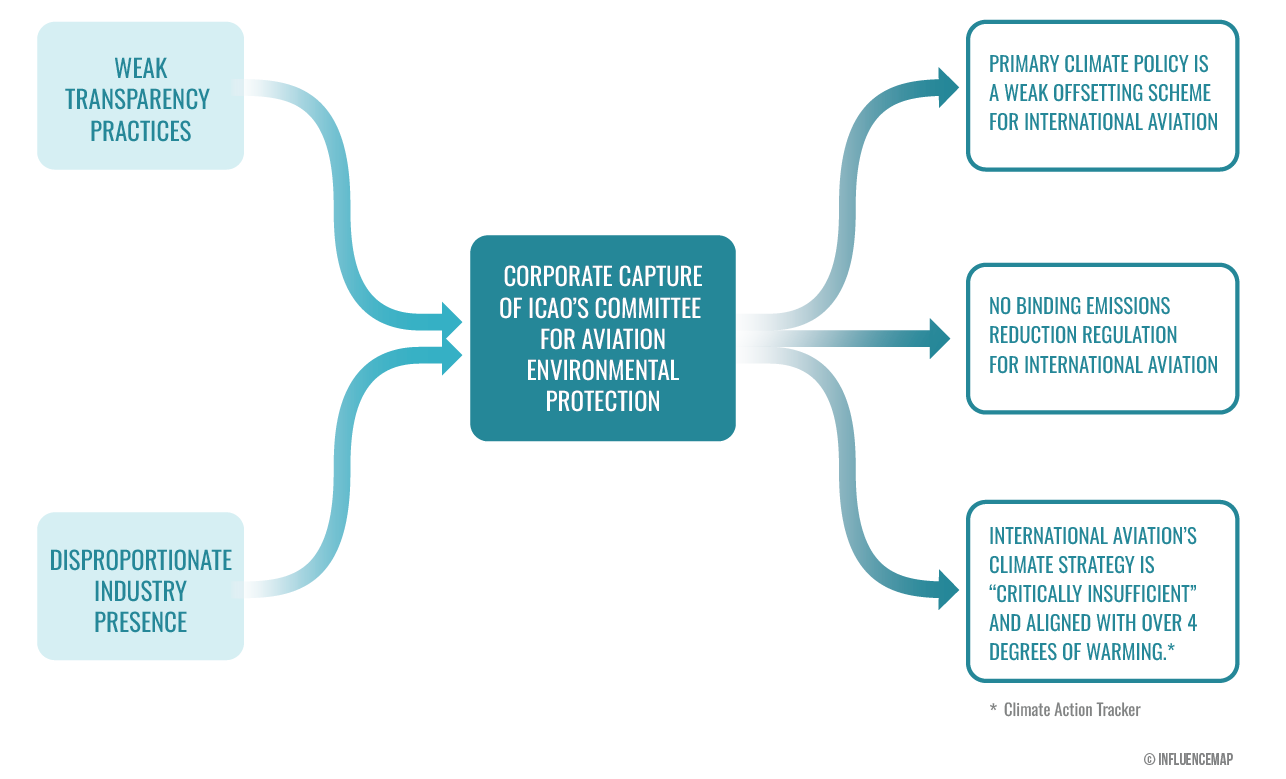■ Updated InfluenceMap analysis of the International Civil Aviation Organization (ICAO)’s climate negotiations reveals insufficient transparency and the development of policies disproportionately reflecting industry interests, indicating a strong case of corporate “policy capture.” The OECD defines policy capture as “encompassing any situation where the decisions taken in a policy cycle mainly reflect the interests of a narrow interest group.” In line with this definition, climate measures by ICAO seem to have been shaped by the aviation industry to prioritize its own interests. As a result, climate policy for international aviation is “critically insufficient” (Climate Action Tracker) to meet the sector’s net-zero goals.
■ Analysis of the ICAO’s February 2025 Committee on Aviation Environmental Protection (CAEP) meeting finds that the weak transparency practices identified in InfluenceMap’s 2022 report on the ICAO have persisted. The OECD highlights strong transparency and accountability in policy decision-making as necessary for minimizing the risk of “policy capture.” By contrast, CAEP meetings are closed to the media, delegates must sign non-disclosure agreements, and submissions from participating organizations are not publicly released. The lack of transparency removes opportunities for external scrutiny and accountability for corporate interests and exacerbates the risk of policy capture.
■ Other global climate negotiations, such as the United Nations Framework Convention on Climate Change (UNFCCC) and the International Maritime Organization (IMO), employ more open transparency practices. Unlike at CAEP, delegates can attend UNFCCC and IMO meetings without signing non-disclosure agreements. UNFCCC position papers are publicly available, and authors can elect to publish IMO environment committee submissions.
■ Industry interests outnumbered environmental delegates 14 to one at CAEP’s February 2025 meeting. This report reveals a long-standing trend of disproportionate industry presence at CAEP meetings compared to NGOs since the Paris Agreement, with industry representing approximately 31% of delegates at the four CAEP plenary meetings. Delegates from industry also participate in CAEP working groups, influencing key research that underpins environmental proposals. Such high attendance enables strategic advocacy from a relatively narrow set of corporate interests.
■ Climate policy development at ICAO reflects positions pushed by powerful members of the aviation industry. The International Air Transport Association (IATA), for example—a trade association representing 350 airlines—has been largely successful in its decades-long climate advocacy strategy. Evidence reveals how ICAO is reflecting industry positions in its efforts to get its Member States to oppose environmental taxation proposals for aviation. This follows a long history of IATA shaping the UN body’s climate measures, including proposing, developing, and subsequently successfully campaigning to weaken its main climate rule: the Carbon Offsetting and Reduction Scheme for International Aviation.
■ The combination of weak transparency and disproportionate industry influence has severe consequences for much-needed regulation of the global aviation sector, which has been deemed by Climate Action Tracker as “critically insufficient” for meeting global climate targets. ICAO’s climate measures have been criticized for relying on offsetting for international aviation (CORSIA) rather than binding emissions reduction regulation by climate science and policy experts, such as the Intergovernmental Panel on Climate Change and the Tourism Panel on Climate Change. To address this, both panels have suggested new governance structures around climate in the aviation sector. Despite pressure on multiple fronts, with at least one CAEP member urging increased transparency for effective governance, the organization has yet to improve. However, members did propose an ad-hoc group to discuss governance at the 2025 plenary meeting.
